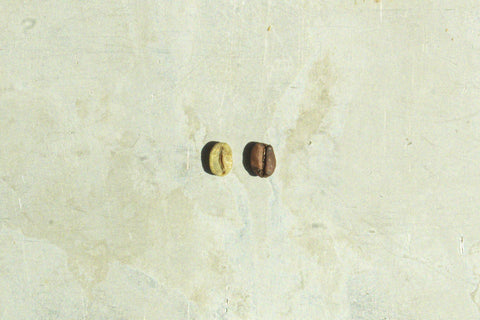Technical information
|
stature of the coffee tree |
grain size |
yield |
|
altitude |
color of the tips of the leaves Bronze |
nematode (root disease) |
Typica is a historic variety of Coffea arabica , whose origins date back to Ethiopia. Considered the ancestor of many other modern varieties, it was introduced to Yemen in the 17th century, where it quickly gained popularity.
The Typica variety was later spread to other parts of the world, including Java and Brazil , from where it became established in coffee-growing regions across Latin America, including Costa Rica , Colombia , and Guatemala . This cultivar played a key role in forming the foundations of modern specialty coffee production and influenced other cultivars such as Bourbon and SL28 .
Typica is now widely cultivated in the mountainous regions of coffee-producing countries, particularly those located between 1200 and 2000 meters above sea level, where growing conditions are ideal for the expression of the complex aromas characteristic of this variety.

Botanical and agronomic characteristics of Typica
Botanically, Typica is a Coffea arabica coffee plant with a relatively open growth structure. It is distinguished by long branches , dark green leaves and a pyramidal shape . This variety has moderate growth , which limits its productivity compared to other, more resistant varieties.
However, its ability to produce high-quality beans makes it a preferred choice for specialty coffee producers . Typica is often preferred for its slow-ripening cherries , a crucial factor that allows for better flavor development .
Typica is particularly susceptible to diseases such as coffee rust and Cercospora leaf spot , but it remains a favorite in regions where growing conditions are optimal and growers are willing to invest in careful farming practices to maintain plant health. Furthermore, its resilience to climate change is limited, highlighting the importance of maintaining stable environmental conditions for quality production.
Chemical composition and determining factors for aroma
The sensory profile of Typica is particularly influenced by its chemical composition. It is rich in lipids and reducing sugars , essential for the complex aromas formed during roasting . Chlorogenates , phenolic acids present in the bean, play a major role in creating the bright acidity frequently found in Typica specialty coffees . The acidity can be particularly pronounced in coffees grown at high altitudes, where the cool temperature allows for slow ripening of the cherries.
In terms of flavor profiles, Typica is known for its floral notes , often described as jasmine or citrus . This variety also offers fruity aromas like peach and plum , especially when processed using methods like washed . Typica can also reveal sweet notes of honey , hazelnut , and sometimes caramel , depending on the processing method and terroir .

Sensory profile of Typica: Influence of processing methods
The sensory profile of Typica varies considerably depending on the processing method chosen. According to World Coffee Research , the processing method decisively influences the aromatic structure of coffee, and in particular that of Typica.
a) Washed method
The washed process is by far the most common for this variety, especially in countries like Colombia , Costa Rica , and Ethiopia . In this process, the coffee cherries are pulped immediately after harvest and then fermented to remove any remaining sugars before being sun-dried. Washed Typica is known for its clear acidity , floral aromas , and depth of flavor , including notes of stone fruit and honey . It is also characterized by a smooth texture and clean taste , making it particularly popular in specialty coffees .
b) Natural method
The natural method , on the other hand, retains the pulp around the bean during the drying process, resulting in a sweeter and fruitier coffee . Typica Natural has aromas of berries , figs and exotic fruits , with a denser texture and a fuller body . This method, although riskier in terms of fermentation management, can offer very interesting profiles for specialty coffee lovers .
c) Honey method
Honey processing combines the techniques of washed and natural processing . It involves leaving some of the mucilage on the beans during drying, which creates additional sweetness and increased complexity. Typica honey reveals sweet flavors like brown sugar , caramel , and sometimes vanilla , while retaining some light acidity .
Typica across the terroirs: Regional variations
Terroirs play a crucial role in expressing the characteristics of Typica . In Ethiopia , for example, this variety is distinguished by its floral aromas and lively acidity , often combined with notes of lemon and grapefruit . In Colombia , Typicas grown at high altitudes produce coffees with bright acidity , chocolate flavors , and a light body . Typica grown in Guatemala is also highly valued for its complex flavors , including notes of caramel , hazelnut , and red fruits .
These regional variations demonstrate the importance of the specific growing conditions of each terroir, which influence not only the aromas, but also the overall quality of the specialty coffee produced from Typica.

Conclusion
The Typica variety remains a benchmark in the world of specialty coffee . While not the most productive of the various Arabica varieties , its ability to produce high-quality specialty coffees gives it a special place in coffee history and culture. Processing methods such as washed , natural , and honey extract the richness of this variety and create unique flavor profiles, ranging from bright acidity to sweet notes of honey and caramel .
Typica thus remains a key element of coffee heritage , contributing to the evolution of specialty coffees worldwide, while influencing the way we perceive and taste coffee in all its diversity.
References
-
World Coffee Research. (nd). Typica variety . Retrieved from https://varieties.worldcoffeeresearch.org/varieties/typica
-
Pereira, AA, de Souza, FF, & Fazuoli, LC (2020). Typica and Bourbon: the genetic basis of the Arabica coffee tree. Coffee Science , 15(1), 85-95.
-
Illy, A., & Viani, R. (2005). Espresso Coffee: The Science of Quality (2nd ed.). Academic Press.
-
International Coffee Organization (ICO). (2021). Coffee Varieties and Production Trends .




Comments (0)
There are no comments for this article. Be the first one to leave a message!